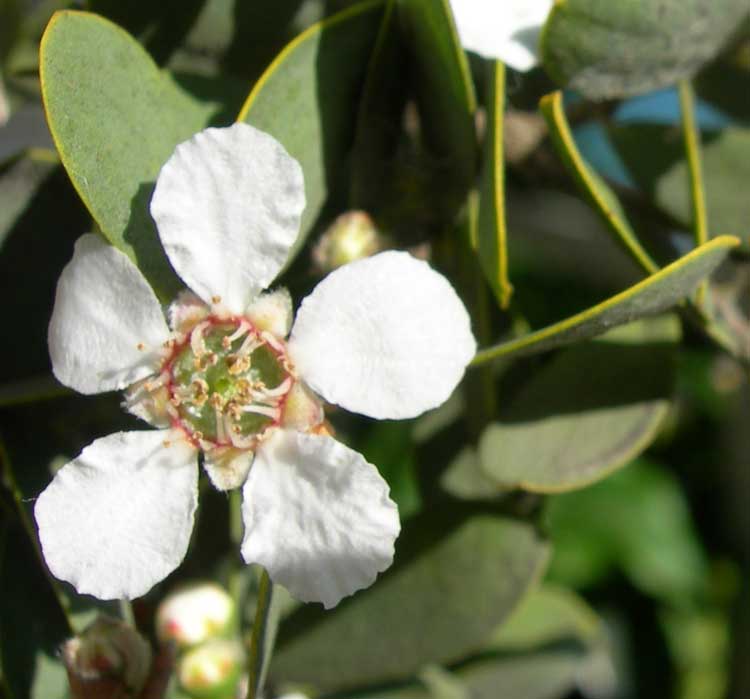
Leptospermum laevigatum, Photo: nps.gov
Classification System: APG IV
Superregnum: Eukaryota
Regnum: Plantae
Cladus: Angiosperms
Cladus: Eudicots
Cladus: Core eudicots
Cladus: Rosids
Cladus: Eurosids II
Ordo: Myrtales
Familia: Myrtaceae
Subfamilia: Myrtoideae
Tribus: Leptospermeae
Genus: Leptospermum
Species: Leptospermum laevigatum
Name
Leptospermum laevigatum (Gaertn.) F.Muell., 1858
References
Ann. Rep. of the Government Botanist and Director of the Botanic Garden, Victoria 22. 1858 (Fragm. 4:60. 1864)
USDA, ARS, Germplasm Resources Information Network. Leptospermum laevigatum in the Germplasm Resources Information Network (GRIN), U.S. Department of Agriculture Agricultural Research Service. Accessed: 07-Oct-06.
Vernacular names
English: Coastal tea tree
Leptospermum laevigatum, commonly known as the coast tea tree,[3] is a species of shrub or small tree that is endemic to south-eastern Australia, but has been widely introduced in other places where it is often considered to be a weed. It has thin, rough bark on the older stems, narrow egg-shaped leaves, relatively large white flowers and flat topped fruit that is shed shortly after reaching maturity.
Description
Leptospermum laevigatum is a bushy shrub or tree that typically grows to a height of 1.5–6 m (4 ft 11 in–19 ft 8 in) and has thin, rough bark on the older stems. The young stems are covered with silky hairs at first and have a groove near the base of the petiole. The leaves are greyish green, narrow egg-shaped with the narrower end towards the base, 15–30 mm (0.59–1.18 in) long and 5–10 mm (0.20–0.39 in) wide on a short petiole. The flowers are borne on short side shoots, usually in pairs of different ages, and are usually 15–20 mm (0.59–0.79 in) wide. There are many reddish brown bracts around the flower buds but most fall off as the flower opens. The floral cup is mostly glabrous, 3–4 mm (0.12–0.16 in) long with the upper part expanded. The sepals are triangular, about 2 mm (0.079 in) long, the petals white, 5–8 mm (0.20–0.31 in) long and the stamens 1.5–2.5 mm (0.059–0.098 in) long. Flowering mainly occurs from August to October and the fruit is a capsule 7–8 mm (0.28–0.31 in) wide with the remains of the sepals initially attached. The fruit mostly fall from the plant shortly after reaching maturity.[3][4][5][6]
Taxonomy and naming
This teatree was first formally described in 1788 by Joseph Gaertner who gave it the name Fabricia laevigata and published the description in his book De Fructibus et Seminibus Plantarum.[7] In 1858, Ferdinand von Mueller changed the name to Leptospermum laevigatum.[8] The specific epithet (laevigatum) is from a Latin word meaning "made smooth" or "having a polished surface".[9]
Distribution and habitat
Leptospermum laevigatum is native to New South Wales, Victoria and Tasmania where it grows in heath, sometimes forest and on coastal dunes and cliffs south from Nambucca Heads in New South Wales to Anglesea in Victoria and northern Tasmania. It has also been introduced to Queensland, South Australia, Western Australia and countries overseas including southern Africa, New Zealand, Hawaii and the Central Coast of California.[3][4][10][11][12]
Ecology
Coast teatree is salt-resistant, very hardy and is commonly used in amenities plantings and coastal plantings. It has also been planted in Western Australia where it has become a weed.[13] This species has been planted along the Central Coast of California in the United States to stabilize sand.[14] It is known there as the Australian tea tree.[15] The seeds can be dispersed by wind and water.[10]
It has now become naturalised in New Zealand, southern Africa, California and Hawaii.[10]
The larvae of Holocola thalassinana feed on Leptospermum laevigatum.[16]
Cultivation
L. laevigatum is planted widely as a garden ornamental or display tree. It is useful as a windbreak or hedging plant and for the rapid stabilisation of sandy soils, and in rehabilitation areas where construction or mining has taken place.[10]
Conservation status
L. laevigatum is not listed on the advisory list of rare or threatened plants in Victoria (2014).[17]
References
IUCN SSC Global Tree Specialist Group.; Botanic Gardens Conservation International (BGCI). (2021). "Leptospermum laevigatum". IUCN Red List of Threatened Species. 2021: e.T199308181A199313185. doi:10.2305/IUCN.UK.2021-2.RLTS.T199308181A199313185.en. Retrieved 23 October 2021.
"Leptospermum laevigatum". Australian Plant Census. Retrieved 12 April 2020.
"Leptospermum laevigatum". Royal Botanic Gardens, Victoria. Retrieved 12 April 2020.
"Leptospermum laevigatum". Royal Botanic Garden Sydney. Retrieved 12 April 2020.
Thompson, Joy (1989). "A revision of the genus Leptospermum (Myrtaceae)". Telopea. 3 (3): 372–373. doi:10.7751/telopea19894902.
"Leptospermum laevigatum". Australian Native Plants Society (Australia). Retrieved 12 April 2020.
"Fabricia laevigata". APNI. Retrieved 12 April 2020.
"Leptospermum laevigatum". APNI. Retrieved 12 April 2020.
Francis Aubie Sharr (2019). Western Australian Plant Names and their Meanings. Kardinya, Western Australia: Four Gables Press. p. 233. ISBN 9780958034180.
"Fact Sheet Index". Weeds of Australia. Queensland Government. Retrieved 20 August 2018.
"Leptospermum laevigatum". University of Tasmania. Retrieved 13 April 2020.
"Leptospermum laevigatum". FloraBase. Western Australian Government Department of Biodiversity, Conservation and Attractions.
Australian Weeds Committee. "Weed Identification - Coastal Tea Tree". National Weeds Strategy. Archived from the original on 2006-08-30. Retrieved 2007-07-18.
"Jepson Manual Treatment". Regents of the University of California. Retrieved 20 August 2018.
"Leptospermum laevigatum (Sol. ex Gaertn.) F. Muell. Australian teatree". USDA. Retrieved 20 August 2018.
tortricid.net. "Holocola".
Advisory list of rare or threatened plants in Victoria (PDF). Department of the Environment and Primary Industries. ISBN 978-1-74146-313-2. Retrieved 5 May 2020.
Retrieved from "http://en.wikipedia.org/"
All text is available under the terms of the GNU Free Documentation License

